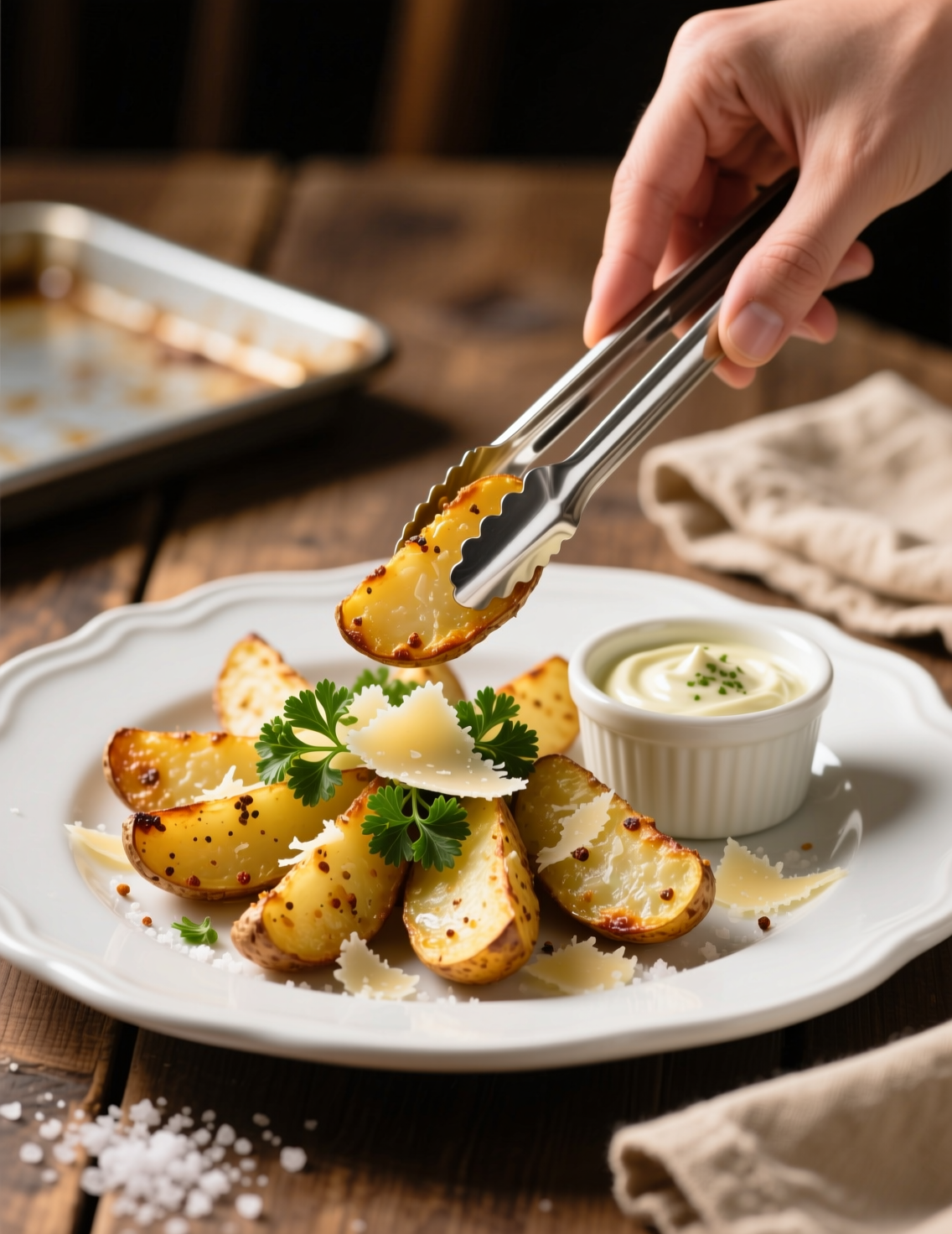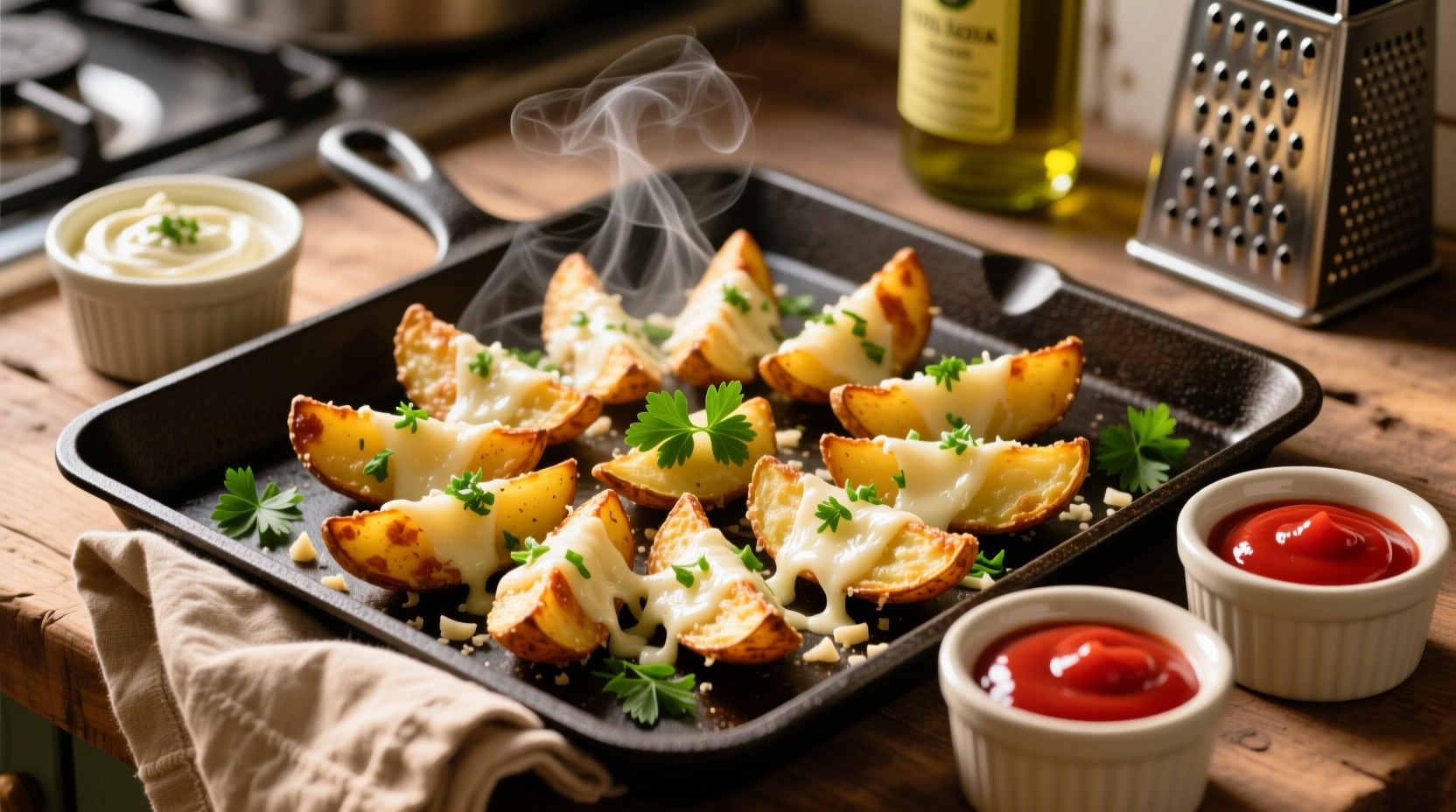There’s something oddly satisfying about the crackle of roasted potatoes as they emerge golden from the oven. These Parmesan Garlic Potato Wedges? They’re the sort of thing that makes a chef close their eyes for a moment, breathe in that buttery-garlic aroma, and think—“Yep, that’s dinner done right.” This recipe isn’t about shortcuts. It’s about understanding heat, timing, and that delicate dance between oil and starch. For six servings, we’re crafting wedges that balance a crisp exterior with a soft, almost creamy interior.
Now, don’t think this is your average “throw it in the oven and hope it crisps” deal. No, this is cooking science in its Sunday clothes. We’ll go into the nitty-gritty—why soaking matters, how temperature creates that satisfying crunch, and why freshly grated Parmesan is non-negotiable.
The Science of the Perfect Potato Wedge
Let’s start with the potato. Russets—those starchy, rough-skinned heroes—are the ideal candidates. Their high starch content ensures that when roasted properly, the edges crisp like toasted bread while the centers stay fluffy. Yukon Golds? They’ll do, but they hold a touch more moisture, meaning slightly less crunch.
The secret many home cooks miss: soaking. When you cut the potatoes into wedges, you’re exposing their starch. That starch, when left on, fights crispiness like oil fights water. A 30-minute soak in cold water removes just enough surface starch to let the edges caramelize evenly. Some chefs even go for a double soak—cold water first, then a quick hot rinse—to draw out excess sugars and starch for an even cleaner roast.
Ingredients: Simplicity Wears a Chef’s Coat
For six servings, you’ll need:
- 4 large Russet potatoes (scrubbed, not peeled—texture matters)
- 3 tablespoons olive oil (extra virgin, preferably cold-pressed)
- 4 cloves garlic, finely minced (fresh, not jarred)
- ½ cup grated Parmesan cheese (freshly grated, not the dusty shelf stuff)
- 1 teaspoon sea salt (adjust after roasting)
- ½ teaspoon freshly ground black pepper
- ½ teaspoon smoked paprika (optional but adds depth)
- 2 tablespoons chopped fresh parsley for garnish
If you want to elevate flavor, add a pinch of garlic powder and onion powder. They cling to oil beautifully and toast into the crust.

Prepping Like a Professional
Preheat your oven to 425°F (220°C). It’s important not to go lower. Potatoes need that initial burst of high heat to form a crust before the interior softens. Line a large baking sheet with parchment paper or a silicone mat. Avoid aluminum foil—it tends to steam the wedges underneath instead of crisping them.
Cut each potato in half lengthwise, then slice each half into 3 or 4 wedges depending on thickness. You want even cuts so they cook uniformly.
Now, soak them. Place the wedges in a large bowl of cold water for at least 30 minutes. You’ll notice the water turning cloudy—that’s the excess starch leaching out. Drain, then pat dry with a clean kitchen towel. Moisture is your enemy here; even a few drops can ruin your crisp.
The Flavor Infusion Stage
In a large mixing bowl, toss the dried potato wedges with olive oil, minced garlic, salt, pepper, and smoked paprika. Get your hands in there. You can’t coat them properly with just a spoon. When every wedge glistens, you’re ready to move forward.
But here’s a chef’s trick—don’t add the Parmesan yet. Heat alters the proteins in Parmesan, and adding it too early can make it burn rather than melt. We’ll add it halfway through baking to get that golden, crusty layer without bitterness.
Oven Mastery: The Right Way to Roast
Spread the wedges out in a single layer, cut side down, ensuring they don’t touch. Overcrowding equals steaming, not roasting. If you’ve got more wedges than space, bake in two batches. Professional kitchens always respect air circulation—it’s what separates crisp from soggy.
Roast in the preheated oven for 20 minutes. Don’t open the door, no matter how tempting that garlic smell is. After 20 minutes, flip each wedge carefully using tongs. Sprinkle the grated Parmesan evenly over them. Return to the oven for another 15 to 20 minutes, until the cheese crisps and the potatoes turn a rich golden brown.
You’ll know they’re done when they feel firm to the touch but not dry. The internal texture should yield gently—soft, but not mushy.
Why Parmesan Works So Beautifully
Parmesan isn’t just there for flavor—it’s chemistry. When Parmesan hits heat, its natural fats melt and brown through the Maillard reaction, creating those umami-packed golden bits that cling to the potato. The saltiness enhances flavor perception while the cheese forms a semi-crisp coating, almost like a shell.
Grated fresh Parmesan, compared to pre-packaged, contains natural oils that help with even caramelization. The difference might sound subtle, but you’ll taste it—the nutty, slightly sharp bite is incomparable.
A Garlic Note Worth Mentioning
Raw garlic burns fast, and burnt garlic is unforgiving. That’s why we add it before roasting but after coating with oil—it forms a protective layer. The oil distributes the heat more evenly, preventing the garlic from crisping too soon. Some chefs roast their garlic separately, then toss it in post-bake, but that loses the infusion that happens when garlic meets hot oil and potato starch simultaneously.
If you want an even more mellow profile, you can substitute part of the fresh garlic with roasted garlic paste. It adds a caramel-like sweetness without losing aroma.
Pairing & Serving Like a Chef
When you plate these wedges, don’t just dump them in a bowl. Presentation counts. Stack them loosely on a platter, sprinkle extra Parmesan, then scatter chopped parsley for contrast. You can drizzle a touch of melted butter mixed with garlic and herbs if you’re feeling indulgent.
For dipping, think beyond ketchup. Try a homemade aioli, ranch infused with lemon zest, or even a Greek yogurt dip with dill and garlic. Professionals often pair crispy potatoes with acidic sauces—the brightness cuts through the richness and enhances overall flavor.
Common Mistakes and How to Avoid Them
1. Overcrowding the pan.
This is the number one reason for soggy wedges. Space equals airflow equals crisp.
2. Not soaking.
Skipping this step leaves surface starch intact, leading to patchy browning.
3. Using low heat.
A 375°F oven might sound safe, but it’s not enough to trigger proper caramelization.
4. Using pre-grated Parmesan.
It often contains anti-caking agents that prevent proper melting and browning.
5. Forgetting to flip.
Flipping ensures even coloration and prevents one side from drying out.

Expert-Level Variations
If you’re bored of the classic, here are some professional-level tweaks:
Truffle Parmesan Wedges – Swap olive oil for a drizzle of truffle oil after baking. The aroma transforms the dish entirely.
Smoky Chipotle Garlic Wedges – Add chipotle powder instead of paprika and serve with lime crema. Perfect with grilled meats.
Rosemary Garlic Parmesan Wedges – Finely chop fresh rosemary and add it halfway through roasting. The herb oils release perfectly at that temperature range.
Crispy Double-Baked Method – Roast once at 425°F for 20 minutes, cool for 10 minutes, then roast again at 450°F for 10 minutes. You’ll get a shattering crispiness that borders on fry-like.
Storage and Reheating
Proper storage maintains texture. Let wedges cool completely before refrigerating. Storing them warm causes condensation, softening the crust. Keep them in an airtight container for up to 3 days.
To reheat, skip the microwave—it’ll undo your hard work. Instead, preheat the oven to 400°F, spread the wedges on a sheet, and bake for 8–10 minutes. The dry heat revives the crunch beautifully.
Nutrition Breakdown (Per Serving)
Approximate values per serving (based on 6 servings):
- Calories: 265
- Protein: 7g
- Fat: 11g
- Carbohydrates: 34g
- Fiber: 3g
- Sodium: 420mg
A well-balanced dish—rich but not heavy. The olive oil and Parmesan contribute healthy fats and protein, while the potatoes provide complex carbs and potassium.
The Chef’s Philosophy Behind It
Cooking isn’t always about complexity—it’s about attention. These Parmesan Garlic Potato Wedges work because every element serves a purpose. The oil seals. The heat caramelizes. The cheese crusts. The garlic perfumes.
I’ve made this dish a hundred times in different kitchens—some quiet, some chaotic. And no matter where, the moment those wedges hit the table, silence follows. That’s the mark of a dish done right.
The real trick? Don’t chase perfection. Chase patience. Let the heat do its work. Let the smell guide you. Trust that every crisp corner is a reward for the few extra minutes you spent soaking, flipping, waiting.
Final Thoughts
These Parmesan Garlic Potato Wedges are proof that simple ingredients, treated with care, can rival anything fancy. They’re humble, yes, but they wear their crisp like armor. Each bite carries that perfect trio—salt, crunch, and depth of flavor.
For professionals, this recipe is a reminder that technique trumps complication. The next time you plan sides for a menu, remember this: sometimes all it takes to make a diner remember your dish isn’t a truffle foam or microgreens—it’s a wedge of potato that crunches just right.
FAQs
What type of potatoes work best for Parmesan Garlic Potato Wedges?
Russet potatoes are ideal because their high starch content makes them crispy outside and fluffy inside.
Why should I soak the potato wedges before baking?
Soaking removes excess starch, helping the wedges crisp up beautifully in the oven.
Can I use pre-grated Parmesan cheese?
It’s not recommended since pre-grated cheese contains anti-caking agents that prevent proper melting.
What temperature should I bake the wedges at?
Bake them at 425°F (220°C) for the best golden, crispy finish.
How long should I bake Parmesan Garlic Potato Wedges?
Bake for 35–40 minutes total, flipping halfway through for even browning.
When should I add the Parmesan cheese?
Add it halfway through baking to prevent burning and ensure even crisping.
Can I make these wedges ahead of time?
Yes, bake them once, cool completely, and reheat in the oven before serving.
What’s the best way to reheat leftover wedges?
Reheat in a 400°F oven for 8–10 minutes to restore crispiness.
How do I keep my wedges from sticking to the pan?
Use parchment paper or a silicone baking mat for easy release and even cooking.
Can I make these wedges in an air fryer?
Absolutely—cook at 400°F for 15–18 minutes, shaking halfway through for even crisping.
What dips go well with Parmesan Garlic Potato Wedges?
They pair beautifully with garlic aioli, ranch, or a zesty yogurt-based dip.
How can I make them extra crispy?
Double-bake them or ensure they’re completely dry before tossing in oil.
Can I add herbs to this recipe?
Yes, rosemary, thyme, or parsley add lovely aroma and depth of flavor.
Are these wedges gluten-free?
Yes, all the ingredients are naturally gluten-free if you use certified Parmesan.
How long can I store leftover wedges?
Keep them in an airtight container in the fridge for up to three days.

Mariana is a passionate home cook who creates delicious, easy-to-follow recipes for busy people. From energizing breakfasts to satisfying dinners and indulgent desserts, her dishes are designed to fuel both your body and hustle.
When she’s not in the kitchen, she’s exploring new flavors and dreaming up her next recipe to share with the Foodie Hustle community.

